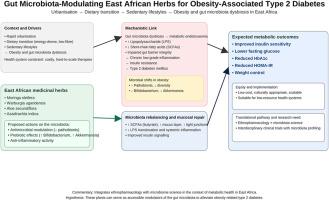东非传统药用植物作为肥胖相关糖尿病肠道微生物群的调节剂:简短的交流
Q2 Medicine
引用次数: 0
摘要
在东非,由于城市化、饮食改变和久坐不动的生活方式,肥胖和2型糖尿病(T2DM)的患病率正在迅速上升。根据国际糖尿病联合会(IDF)的数据,撒哈拉以南非洲地区4.2%的成年人口(2400万人)患有糖尿病,预计到2045年将超过5500万人,东非将承担公平的负担。肠道菌群失调,即产生短链脂肪酸(SCFA)的细菌的减少和促炎菌群的增加,是肥胖和2型糖尿病之间的关键机制联系。传统的药物,包括二甲双胍、磺脲类药物、胰岛素和新的抗肥胖药物,在临床上都是有效的,但它们价格昂贵,不易获得,而且在东非人口中耐受性低。相反,本地药用植物辣木、乌干达瓦布吉、芦荟和印楝在临床上是可获得的、可接受的,它们具有抗菌、益生元和抗炎的植物化学物质,可能会改变肠道微生物群的组成和活性。这篇短文叙述性地回顾了2015年至2025年在PubMed、Scopus、Web of science和谷歌Scholar上在民族药理学、植物化学和微生物组科学领域的最新发现。讨论的重点是植物化学-微生物群相互作用与代谢健康结果之间的转化途径,以及证据基础中的现有差距和东非环境中系统方法和临床验证的需求。我们建议跨学科试验,包括植物化学标准化或微生物组测序和文化上合适的社区方法。本文章由计算机程序翻译,如有差异,请以英文原文为准。

Traditional East African medicinal plants as modulators of gut microbiota in obesity-associated diabetes: A short communication
The prevalence of obesity and type 2 diabetes mellitus (T2DM) is rapidly growing in East Africa as a result of urbanisation, changing diets, and sedentary lifestyles. According to the International Diabetes Federation (IDF), 4.2 per cent of the adult population in sub-Saharan Africa (24 million people) has diabetes, which is expected to be more than 55 million by 2045, with East Africa making its fair share of the burden. Gut microbiota dysbiosis, which is observed as the loss of short-chain fatty acid (SCFA)-producing bacteria and a rise in the pro-inflammatory taxa, is a key mechanistic connection between obesity and T2DM. The traditional medications, including metformin, sulfonylureas, insulin, and the new anti-obesity medications, are all clinically effective, but they are expensive, less available, and have low tolerance in the East African population. Conversely, native medicinal plants Moringa oleifera, Warburgia ugandensis, Aloe secundiflora, and Azadirachta indica are clinically accessible, acceptable and have antimicrobial, prebiotic, and anti-inflammatory phytochemicals that can potentially alter the composition and activity of gut microbiota. This short communication narratively reviewed recent discoveries in the fields of ethnopharmacology, phytochemistry, and microbiome science in PubMed, Scopus, Web of Science, and Google Scholar from 2015 to 2025. The discussion focuses on the translational pathways between phytochemical-microbiota interactions and metabolic health outcomes, as well as the existing gaps in the evidence base and the need for systematic methodologies and clinical validation in East African settings. We suggest interdisciplinary trials that include phytochemical standardisation or microbiome sequencing and culturally appropriate community-based approaches.
求助全文
通过发布文献求助,成功后即可免费获取论文全文。
去求助
来源期刊

Obesity Medicine
Medicine-Public Health, Environmental and Occupational Health
CiteScore
5.50
自引率
0.00%
发文量
74
审稿时长
40 days
期刊介绍:
The official journal of the Shanghai Diabetes Institute Obesity is a disease of increasing global prevalence with serious effects on both the individual and society. Obesity Medicine focusses on health and disease, relating to the very broad spectrum of research in and impacting on humans. It is an interdisciplinary journal that addresses mechanisms of disease, epidemiology and co-morbidities. Obesity Medicine encompasses medical, societal, socioeconomic as well as preventive aspects of obesity and is aimed at researchers, practitioners and educators alike.
 求助内容:
求助内容: 应助结果提醒方式:
应助结果提醒方式:


